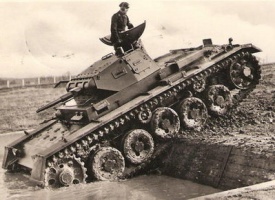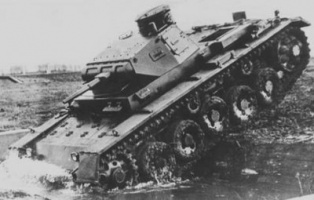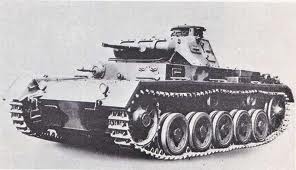Pz.Kpfw. III Ausf. A
PzIII_A (Stock)
| 35000 Precio |
| 200 Puntos de impacto |
| 14.6 / 15.45 kgPeso |
- Comandante
| 14.5/14.5/14.5Blindaje del chasis(frontal/laterales/trasero, mm) |
| 14.5/14.5/14.5Blindaje de la torreta(frontal/laterales/trasero, mm) |
| 320 CVPotencia del motor |
| 68 km/hLímite de velocidad |
| 40 grados/sVelocidad de rotación |
| 36 Daño de proyectil estándar |
| 40 mmPerforación estándar del proyectil |
| 2.3 Tiempo en completar carga |
| 44 grados/sVelocidad de rotación torreta |
| 320 mCampo de vista |
| 310 mAlcance de radio |

Pz.Kpfw. III Ausf. A
Stock
| Nivel | Torreta | Peso (t) | Blindaje de la torreta (frontal/laterales/trasero, mm) | Velocidad de giro del cañón (gra/s) | Alcance de visión (m) | |
|---|---|---|---|---|---|---|
 |
II | PzKpfw-III-Turm Ausf. A | 800 | 14.5/14.5/14.5 | 44 | 320 |
| Nivel | Cañón | Peso (t) | Penetración media (mm) | Cadencia de tiro | Dispersión a 100 m | Tiempo de apuntamiento | ||
|---|---|---|---|---|---|---|---|---|
 |
I | 3,7 cm KwK 36 L/46.5 | 100 | 40/74/18 | 36/36/42 | 26.09 | 0.46 | 1.7 |
| Nivel | Motor | Peso (t) | Potencia del motor (c.v.) | Probabilidad de incendio tras disparo | |
|---|---|---|---|---|---|
 |
IV | Maybach HL 108 TR | 450 | 320 | 20 |
| Nivel | Suspensión | Peso (t) | Límite de carga | Velocidad de giro (gra/s) | |
|---|---|---|---|---|---|
 |
II | PzKpfw-III-Ketten Ausf. A | 7000 | 15.45 | 40 |
| Nivel | Radio | Peso (t) | Alcance de radio (m) | |
|---|---|---|---|---|
 |
III | FuG 5 | 0 | 310 |
PzKpfw IIIC II
Attack
| Nivel | Torreta | Peso (t) | Blindaje de la torreta (frontal/laterales/trasero, mm) | Velocidad de giro del cañón (gra/s) | Alcance de visión (m) | |
|---|---|---|---|---|---|---|
 |
II | PzKpfw-III-Turm Ausf. A | 800 | 14.5/14.5/14.5 | 44 | 320 |
| Nivel | Cañón | Peso (t) | Penetración media (mm) | Cadencia de tiro | Dispersión a 100 m | Tiempo de apuntamiento | ||
|---|---|---|---|---|---|---|---|---|
 |
I | 2 cm KwK 38 L/55 | 70 | 23/46/18 | 11/11/42 | 153.85 | 0.57 | 1.6 |
| Nivel | Motor | Peso (t) | Potencia del motor (c.v.) | Probabilidad de incendio tras disparo | |
|---|---|---|---|---|---|
 |
IV | Maybach HL 108 TR | 450 | 320 | 20 |
| Nivel | Suspensión | Peso (t) | Límite de carga | Velocidad de giro (gra/s) | |
|---|---|---|---|---|---|
 |
II | PzKpfw-III-Ketten Ausf. A | 7000 | 15.45 | 40 |
| Nivel | Radio | Peso (t) | Alcance de radio (m) | |
|---|---|---|---|---|
 |
III | FuG 5 | 0 | 310 |
PzKpfw IIIA (2 cm)
Speed
| Nivel | Torreta | Peso (t) | Blindaje de la torreta (frontal/laterales/trasero, mm) | Velocidad de giro del cañón (gra/s) | Alcance de visión (m) | |
|---|---|---|---|---|---|---|
 |
II | PzKpfw-III-Turm Ausf. A | 800 | 14.5/14.5/14.5 | 44 | 320 |
| Nivel | Cañón | Peso (t) | Penetración media (mm) | Cadencia de tiro | Dispersión a 100 m | Tiempo de apuntamiento | ||
|---|---|---|---|---|---|---|---|---|
 |
I | 2 cm KwK 38 L/55 | 70 | 23/46/18 | 11/11/42 | 153.85 | 0.57 | 1.6 |
| Nivel | Motor | Peso (t) | Potencia del motor (c.v.) | Probabilidad de incendio tras disparo | |
|---|---|---|---|---|---|
 |
IV | Maybach HL 120 TR | 510 | 350 | 20 |
| Nivel | Suspensión | Peso (t) | Límite de carga | Velocidad de giro (gra/s) | |
|---|---|---|---|---|---|
 |
III | PzKpfw-III-Ketten Ausf. B | 7000 | 19.35 | 44 |
| Nivel | Radio | Peso (t) | Alcance de radio (m) | |
|---|---|---|---|---|
 |
VI | FuG 7 | 0 | 415 |
PzKpfw IIIA (5 cm)
Defense
| Nivel | Torreta | Peso (t) | Blindaje de la torreta (frontal/laterales/trasero, mm) | Velocidad de giro del cañón (gra/s) | Alcance de visión (m) | |
|---|---|---|---|---|---|---|
 |
III | PzKpfw-III-Turm Ausf. C | 2200 | 30/30/30 | 35 | 320 |
| Nivel | Cañón | Peso (t) | Penetración media (mm) | Cadencia de tiro | Dispersión a 100 m | Tiempo de apuntamiento | ||
|---|---|---|---|---|---|---|---|---|
 |
III | 5 cm KwK 38 L/42 | 700 | 60/96/25 | 70/70/90 | 24 | 0.48 | 2.3 |
| Nivel | Motor | Peso (t) | Potencia del motor (c.v.) | Probabilidad de incendio tras disparo | |
|---|---|---|---|---|---|
 |
IV | Maybach HL 120 TRM | 510 | 440 | 20 |
| Nivel | Suspensión | Peso (t) | Límite de carga | Velocidad de giro (gra/s) | |
|---|---|---|---|---|---|
 |
III | PzKpfw-III-Ketten Ausf. B | 7000 | 19.35 | 44 |
| Nivel | Radio | Peso (t) | Alcance de radio (m) | |
|---|---|---|---|---|
 |
VII | FuG Spr. 1 | 0 | 455 |
PzKpfw IIIC III
Attack
| Nivel | Torreta | Peso (t) | Blindaje de la torreta (frontal/laterales/trasero, mm) | Velocidad de giro del cañón (gra/s) | Alcance de visión (m) | |
|---|---|---|---|---|---|---|
 |
III | PzKpfw-III-Turm Ausf. C | 2200 | 30/30/30 | 35 | 320 |
| Nivel | Cañón | Peso (t) | Penetración media (mm) | Cadencia de tiro | Dispersión a 100 m | Tiempo de apuntamiento | ||
|---|---|---|---|---|---|---|---|---|
 |
II | 2 cm Flak 38 L/112 | 110 | 39/51/18 | 11/11/42 | 153.85 | 0.45 | 1.4 |
| Nivel | Motor | Peso (t) | Potencia del motor (c.v.) | Probabilidad de incendio tras disparo | |
|---|---|---|---|---|---|
 |
IV | Maybach HL 120 TRM | 510 | 440 | 20 |
| Nivel | Suspensión | Peso (t) | Límite de carga | Velocidad de giro (gra/s) | |
|---|---|---|---|---|---|
 |
III | PzKpfw-III-Ketten Ausf. B | 7000 | 19.35 | 44 |
| Nivel | Radio | Peso (t) | Alcance de radio (m) | |
|---|---|---|---|---|
 |
VII | FuG Spr. 1 | 0 | 455 |
Compatible Equipment
Compatible Consumables
Player Opinion
Pros and Cons
Pros:
- Good Power/Weight ratio means good acceleration
- Good hull traverse speed
- Very good top speed
- Good penetration, damage and rate of fire
Cons:
- Very inaccurate guns
- Weak armor
- Higher chance of engine fire
- Low maneuverability at speed
- Upgraded turret slows the tank down
Performance
The Pz.Kpfw. III Ausf. A boasts an excellent top speed and maneuverability. It excels in the scout role, and after learning the ropes in tiers 1 and 2, players should find this to be an enjoyable next step. It does have drawbacks such as paper-thin 14mm armor (except for the turret which has 30mm all around), and its stock gun is not much more powerful than those found on the previous two tiers. However, once fully upgraded, it is more than a match for the equivalent Soviet and American tanks. It also excels in an anti-scout role such as taking down faster tanks such as the BT-7 that it can penetrate consistently. To make up for the longer aim time, it can take up a "scout-sniper" role in that it can first rush ahead to spot the enemies, and as soon as it makes first contact with the enemy it can then escape with its good speed and then take up a better sniping position to take out the arriving enemies. The gun can and will absolutely decimate hordes of enemies unaware of the tanks position and will rarely need to be well aimed considering the 5cm gun used.
Early Research
- The 2cm Flak 38L/112 gun and the FuG-7 and FuG Spr.1 radios carry over from the Pz.II and should be mounted if already researched.
- Prioritize the 2nd turret which must be mounted before next mounting the 5cm top gun.
- Tracks next followed by the 2nd and 3rd engines.
- Last, but not least, research and mount the Tier-8 radio for great signal range if not carried over from the Pz.II.
Historical Info
Under General Heinz Guderian, a project was commenced to solicit designs for two new types of tank. One would be a support tank and would be armed with a large caliber gun. The other would be mounting an anti-tank gun and 2 machine guns. The former would become the Pz.Kpfw. IV. The latter would become the Pz.Kpfw. III.
Late in 1935, development proposals were requested from MAN (Nurnberg), Daimler-Benz AG (Berlin-Marienfelde), Rheinmetall-Borsig (Berlin), and Krupp AG (Essen) for a 15-ton fully-tracked vehicle, and in the interest of security to be named Zugfuhrerwagen (ZW): platoon commander’s vehicle.
The vehicle's development began with a series of arguments between the Waffenamt (the Ordnance Department) and the Inspector for Mechanized Troops over its armament. The Waffenamt had chosen the 3.7cm cannon while the Inspector for Mechanized Troops demanded 5cm gun. Ultimately, the 3.7cm was chosen as the vehicle's main armament because the infantry was already equipped with the standard 37mm Pak 35/36 L/45 anti-tank gun. This meant that only one type of gun and ammunition needed to be produced, although the turret and turret ring were capable of mounting the heavier 5cm gun.
Since this new vehicle was to be used in the forward echelons of assault tank formations, it was decided to require heavier armor in the front than in the rear. Top speed was specified to be 40km with a crew of 5 men, with a new turret based on an enlarged version of that found on the Pz.Kpfw. II. The Pz.Kpfw. III Ausf. A was the first German Tank to use a new intercom system for in-tank communications, which was fitted to all later Panzer tanks, and was highly successful.
Eventually, the Daimler-Benz design was selected and ten prototypes were constructed in 1937. Some sources state that as many as fifteen were constructed, but only eight were armed. These eight equipped units of the 1st, 2nd, and 3rd Panzer Divisions and took part in Anschluss, the take-over of Sudetenland and the Polish Campaign.


